
Lead generation is not all about getting random potential clients. It’s about getting them so close to a purchase decision that all you have to do is grab their...
Which lead generation strategies actually work?
There’s a ton of same-old unhelpful advice around lead gen out there. Lack of coherent information is holding many marketers back from leveraging reliable strategies that actually increase the number of usable leads generated and converted.
Before we look at what actually does work, let’s look at the lead gen landscape so we know what we’re up against.
No-one knows where B2B leads come from.
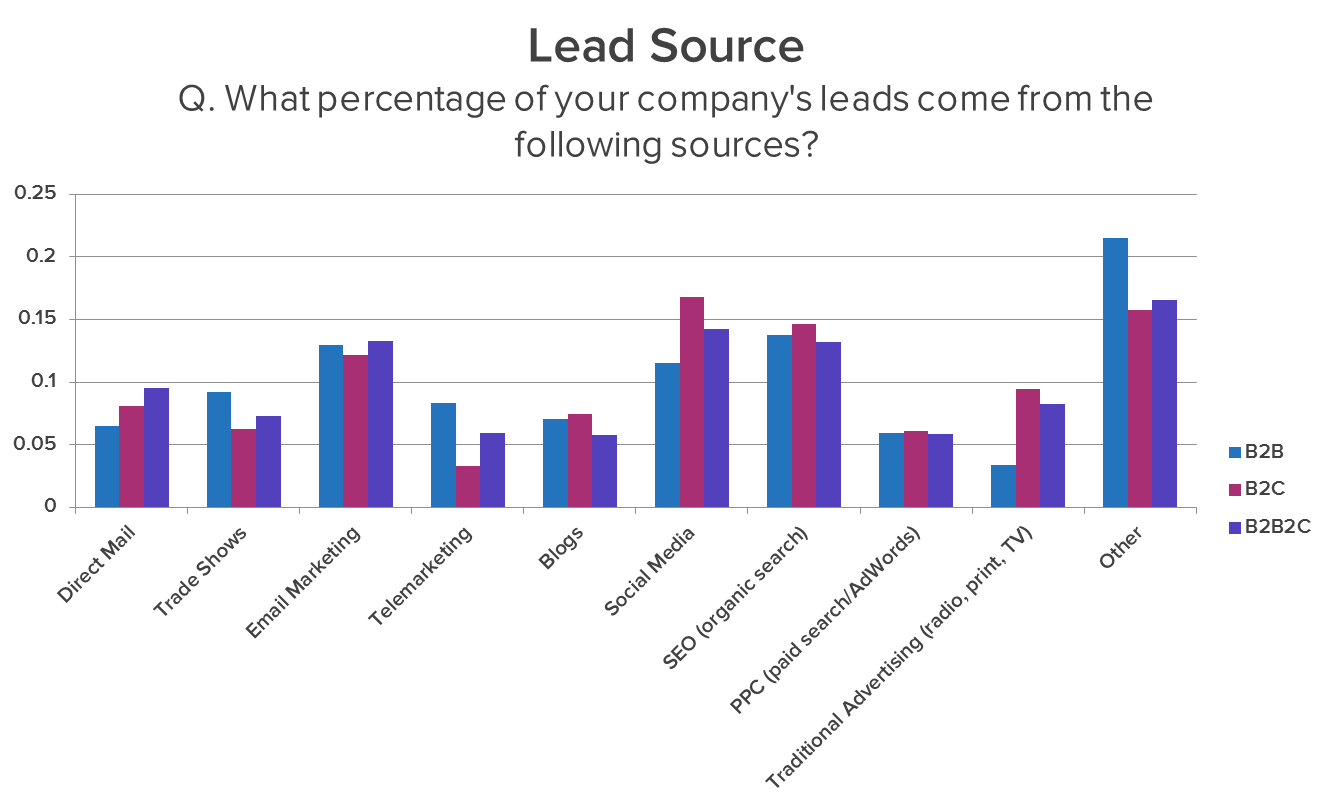
(Source: https://blog.hubspot.com/marketing/where-do-marketers-get-leads-data)
The biggest bar on that graph is ‘other.’
We should note that the graph doesn’t show lead quality or lead conversion rate by channel, just raw numbers - which is why social appears to outperform email, blogging and search.
What we do know is that most B2B marketers rate lead acquisition as among their most important job.
We need more effective strategies to produce leads if we’re to hit those goals.
‘Strategy without tactics is the slowest route to victory; tactics without strategy is the noise made before defeat.’ (Sun Tsu)
That’s very profound, but what does it mean?
Strategy is an overall roadmap for success. It’s about achieving meaningful objectives that advance you toward your long-term goals. Tactics are little tricks to squeeze a few extra percent effectiveness out of your strategy.
For instance, email marketing is a strategy; working to improve email subject lines is a tactic. It’s part of an overall plan or approach but it won’t get you there by itself.
Speaking of which, let’s hit the first of our ten B2B lead gen strategies that work in 2018.
Social media user numbers have peaked and begun to fall.

(Source: http://www.edisonresearch.com/infinite-dial-2018/)
Facebook’s active user numbers actually fell for the first time ever this year.
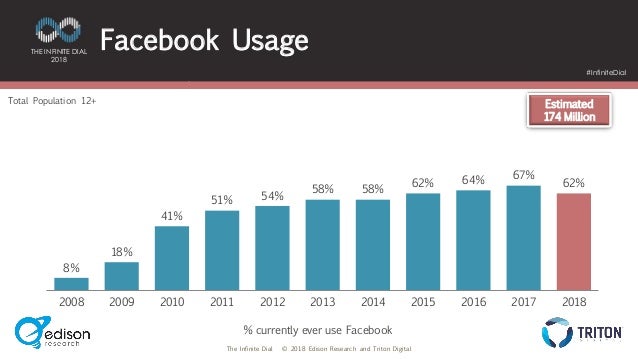
(Source: http://www.edisonresearch.com/infinite-dial-2018/)
Note that a majority of people still use Facebook and still use social media.
However, these channels aren’t a great source of B2B leads; they’re high-use, low-lead channels.
It’s not that Facebook is going the way of Myspace, or that social never generates leads.
It’s just that new kids on the block - including video, which can also be very useful - have generated a lot of noise. In the background, one channel has gone on being the most successful, highest-ROI method of generating B2B leads there is.
Email is 47 years old this year. And it’s still among the best channels out there for generating high-quality B2B leads.
Email consistently delivered high volumes of high quality leads with low ROI across all that time. It topped the chart last year too.
For 2018?
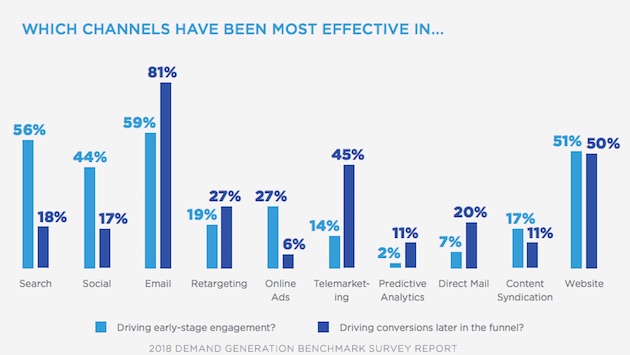
(Source: https://www.marketingprofs.com/charts/2018/33629/b2b-demand-generation-marketers-favorite-tactics)
A demand generation survey of B2B marketing professionals shows email consistently winning at both early-stage engagement, and conversions.
In other words, marketers who want the kind of leads that actually become sales should be looking at email. (Search is nearly as effective at driving early-stage engagement; website optimization runs second place to email overall.)
No algorithm or News Feed changes come between you and your email subscribers.
But lists can and do decay year on year, by an average of 22.5%; work to keep email lists accurate so they stay effective.
No-one subscribes to your emails unless they want to hear from you. But, sometimes people will give a phony or spam-catcher email to download your content without being harassed.
Yes, that’s consumers. But the ‘zombie email’ effect is real across all industries, introducing worthless noise into your data and distorting your conversion rate.
Un-gate and make subscription voluntary to keep lead quality high.
Most B2B leads aren’t ready to buy as soon as they’re generated. Especially for big-ticket items, hotly-contested spaces or new developments, there’s a sometimes-lengthy period of nurturing and education that can last two years or more. Email is ideally suited to communicating with leads at every stage of the process - probably why it has such a high conversion rate.
There are some rules of thumb that everyone should know by now about content marketing. And most of them are plain wrong.
Despite the background hum that seems to indicate a correlation that’s both solid, and clearly causative.
It turns out to be a lot more complex than that.
Longer blog posts don’t get more traffic.
More frequent blog posts don’t generate more traffic.
That’s - well, Rand says it’s just not true.
Instead, blogging that accurately targets your audience is effective. It’s that tactic/strategy mismatch again - too many folks are looking for a way to increase lead gen results without learning about their audience, offering genuinely useful or unique insights, and matching the form of the content they’re offering with their audience.
There isn’t one.
Better content strategy generates more traffic that becomes leads.
That means recognizing that content isn’t just blogging - though blogging should still be the bedrock of an effective content strategy.
The first trouble with an effective content strategy is that many of us have nothing to work with.
That is 59% of B2B marketers who don’t know what success would even look like.
There’s the problem.
Before you can plan to achieve something, you have to actually know what it will look like to get there.
Sounds silly, but look at how few B2B marketers are prepared to answer the simple question, ‘how will we know if it works?’
No wonder content marketing displays such a weird gulf between what it can achieve for some businesses, and what it does achieve for many businesses.
Blogging may not even be the most effective content marketing channel anymore - though that doesn’t mean you should stop doing it!
A 2017 survey found that blogging still topped marketers’ list of B2B content approaches:
But video and interactive content are close behind blogging in efficacy and popularity.
The takeaway from this is that we need to be matching form and content to both audience member and buying journey stage - something only half of marketers now do:
Content works when it’s...
Email is number one for this; social audiences number two.
Cranking out content is part of what you need to do. Intelligently promoting it is a huge component too - and ‘tweet it more’ isn’t the same thing as intelligently promoting it.
Here’s a checklist to start figuring out which of your existing content to expend resources on:

(Source: http://contentmarketinginstitute.com/2018/01/improve-content-marketing-2018/)
The average piece of content is a flop. This chart shows two things:

(Source: https://moz.com/blog/how-to-create-content-that-keeps-earning-links)
One: shares and links don’t line up.
Two: the average blog post gets neither.
Writing blog posts or creating videos or presentations that match the standards you’re used to seeing will get you the same results as everyone else.
How do you avoid that grim fate?
Bring in experts. Hire people with expertise to write your content, produce your videos and design your interactive content. You’ll see increased ROI from radically increased quality.
SEO continues to deliver. Organic search is the source of high-converting, high-ROI B2B leads. It consistently ranks second in overall effectiveness for B2B lead generation, after email marketing.
And last year it tied for number one.
But it’s also an ever-changing arena. Google changes its algorithm, and the digital marketing world changes from other pressures too. It all impacts on SEO. So much so that much of what used to be SEO common sense is now no longer true.
Some pages rank without containing the keywords in the search phrase at all, because of Google’s shift over to semantic search.
But some things are still true.
Search matters. 71% of B2 workers start any research they do with a generic Google search. 55% of all clicks still go the first three organic search results.
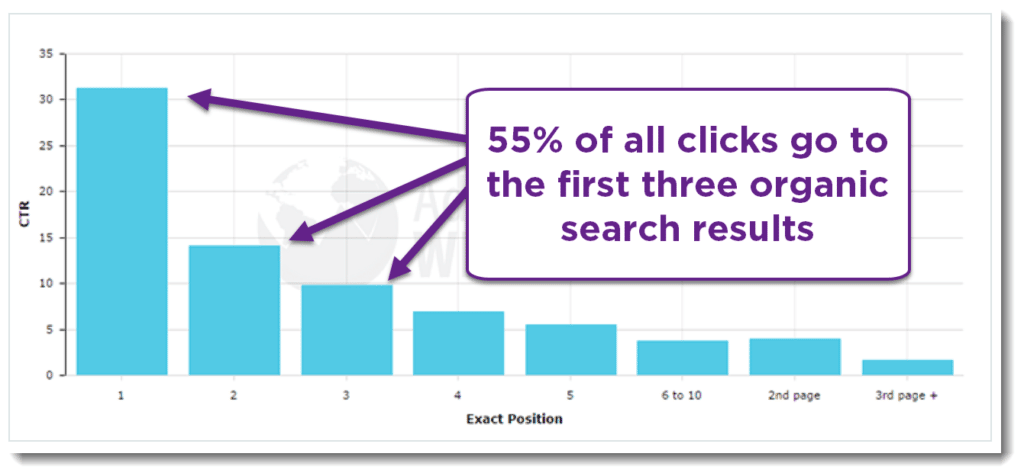
(Source: https://www.bluecorona.com/blog/google-ranking-factors-2018)
However, it’s worth bearing in mind that those clicks might not be lead-generating or converting clicks, and traffic by itself is a vanity metric.
Assuming you’re getting the right traffic, though, organic search delivers higher quality leads than any other source of website traffic.
How do you make that happen?
Well, we know what moves the needle most: site load speed, domain authority, content relevance.
When it comes to written content, that looks pretty much like this:
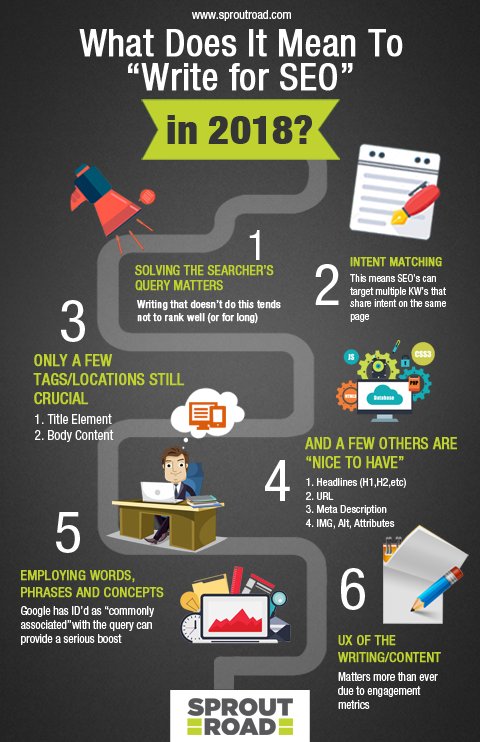
(Source:https://twitter.com/SproutRoad/status/961212338140524544)
If you’re a local business, know that proximity to searcher is the number one ranking signal now.
There’s nothing wrong with video marketing. It’s just not the be all and end all. The ‘pivot to video’ that created so much fuss and then fizzled isn’t the same thing as carefully, effectively using video to generate B2B leads.
Video is effective because it’s entertaining and easy to follow. But it’s not suitable for every stage of the journey or for everyone in your audience.
Who doesn’t want to see video?
Overwhelmingly, top-level executives would rather read about it. They look for branded but non-sales articles that are rich in information - unsurprisingly, since that’s what they use to make all their other business decisions.
But account-based marketing demonstrates that we need to sell to the whole company, and making leads of executives is tough.
There’s value in getting the attention of people closer to the coalface and in more specialized roles.
And plenty of those people prefer video.
It’s especially good for instructional content, and there’s no marketing like an effective product demo. But explainer videos can be hugely effective too.
They let you overcome some of the friction of educating leads about the value of your product, because most people find video inherently more enjoyable than reading static text.
When Crazy Egg created an effective, well-thought-out and engaging explainer video, they saw conversion rates leap by 64% and generated an additional $21,000 in revenue - a month.
Ads in search and on platforms like Facebook and LinkedIn can be powerful tools to generate B2B leads. They have to be done right though - otherwise they’re just money sinks.
PPC ads are one of the most cost-effective ways to do directly paid-for lead generation.
Typically, Adwords clicks are about 50% more likely to make a purchase than organic visitors - and it looks like around half your audience probably don’t really notice the difference between paid and organic results.
Paid ads let you sculpt the traffic you want. That’s true on LinkedIn, where account-based marketers are catered to with ad targeting that takes into account company, role and professional interests among other factors:
 (Source: https://www.ppchero.com/linking-up-with-linkedin-a-beginners-guide/)
(Source: https://www.ppchero.com/linking-up-with-linkedin-a-beginners-guide/)
And it’s especially true on Facebook where the huge tranche of user data lets you target audiences very, very precisely.
This also means you can use paid ads to inform organic search and other lead generation efforts. Facebook ads can validate a marketing funnel. PPC ads can generate keyword, click-through and audience data that can be fed back into SEO campaigns.
Bonus points for ads on non-Google search engines, where CPC can often be much lower for the same keywords. Google’s market dominance can hide opportunities.

That leaves 21% of potential traffic still to play for, an opportunity likely to be most appealing to smaller businesses.
Tools are one of the most effective marketing methods out there. They’re interactive, and they offer value up front - key points in a web that’s in danger of being overwhelmed by mediocre content that does neither.
Not only does it help content creators with a sometimes-tricky element of the gig, but it foregrounds the wider value of using CoSchedule. And that CTA under the ‘analyze’ box is there for the clicking every time someone uses that page.
Does it work?
Well, it sure generates traffic.
That’s CoShedule’s top pages. The headline analyzer outperforms the homepage, drawing in traffic that Ahrefs estimates is worth $3,954.
(Note that three blog posts outperform the tool!)
Or how about Effin Amazing’s UTM builder?
Again, does it work?
In Effin’s case, the tool outperforms its top blog posts, which themselves outperform the homepage.
Each of these tools is a powerful SEO advantage too. Effin Amazing’s tool ranks #2 for ‘utm code generator,’ which has between 1,000 and 10,000 monthly searches and low competition.
CoSchedule’s ranks #1 for ‘headline analyzer,’ another 1k-to-10k keyword with low competition.
Both these tools are free giveaways but they generate leads more effectively than some paid channels.
A lot of marketers have too digital an outlook. But in-person events can be a way to generate a lot of interested leads. That probably explains their place in the hierarchy of predicted successful activities from CMI’s 2017 survey:
You can get leads who want to buy right now, and others that are happy to sign up for your emails or download your content.
It’s important to make sure that the content you take to events is on point too:
It’s one of the most important venues for content distribution, not just a place to hand out business cards. LeadForensics’ Jennifer Hall advises, ‘don’t let anyone leave empty-handed,’ and that’s good advice. But you’ll get better results with something that’s a little more memorable that the standard swag that’s given out at all events.
And remember that ‘in person’ doesn’t mean you have to literally be there. Digital events can be powerful too:
Marketing automation is simply about automating the simpler, more time-consuming elements of lead gen that you’re currently doing yourself. Around 85% of B2B marketing organizations are either already using marketing automation or looking into it.
And the top two reasons organizations use marketing automation are ‘increase sales’ and ‘generate more leads.’
The most typical activities to automate first include email nurturing, cold outreach and social, since these involve the greatest amount of effort. High reward/effort activities like content creation and strategy typically can’t be automated, though the collection of the data to support them can be.
Automate what you can easily, effectively automate; structure what you can’t and try to identify things to simply get rid of.
Automation should consume the bottom of the Eisenhower square.
Nurturing, research, outreach and data crunching to match audiences and identify leads can all be done by machine much better than by humans, and much faster.
Social media isn’t ‘bad’ or ‘good’ except in so far as it generates the kinds of leads we want.
Twitter doesn’t.
But what does?
LinkedIn does.
And Facebook ads with their tightly defined demographics can be effective for validating audences and even discovering new ones.
Much of the reason that B2B businesses don’t get much lead gen juice out of social is that they go about it the wrong way. Noisy channels like Twitter don’t translate over to website traffic very much - let alone to leads. Even if your posts are getting shared, the chances are that no-one’s reading them.
LinkedIn lets users target ads and - perhaps most importantly - join stable groups, two traits it shares with the second most effective B2B channel, Facebook.
Each also allows businesses to sponsor posts, which ‘ frequently drive the lion’s share of traffic for a LinkedIn campaign,’ says PPC Hero’s William Larcom.
Closely targeting an audience and supplying them with strongly-promoted high-quality content a tough act to beat.
Time was, podcasts were just what guys with too much time on their hands did; a podcast was the 2015 equivalent of a blog in 2000. But just like blogs grew up into a serious business tool, so did podcasts.
There’s some evidence to suggest that podcasts are actually opening a new angle of approach for business people: people are using them the way they’d use articles, to explore ideas and gain knowledge. But they’re taking advantage of the eyes-free nature of audio to do it in the car, which partly explains why 64% of podcast listeners are tuning in on mobile devices.
That figures with the average number of podcasts listened to per week - one per workday.
And people who are podcast listeners spend a mean 5 hours a week or so listening - again, that adds up to between 0.5 and 1 podcast per commute.
Podcasts are relatively simple to get started - all you need is a decent-quality microphone (don’t skimp on this if you don’t want to sound like you’re broadcasting from the 1930s) and some audio editing tools on your computer - many of which are free.
As with blog posts, there’s a drop off rate to contend with, so multiple calls to action throughout the podcast will be most effective from a lead gen standpoint.
Compared to video, podcasts represent an exciting meeting-point of serious attention and low cost of entry, so it will be interesting to see what happens with them in 2018.
B2B lead generation works best when it’s part of a coherent strategy that spans the upper part of the funnel and takes into account what happens further down. The only way you’re going to get the best value from any B2B strategy is by testing it against your own needs - your numbers, in the end, are the only ones that count.
Having said which, it’s these strategies that will fuel growth in 2018 and beyond for the businesses that adopt them and effectively leverage them.
Did we miss your secret powerhouse? Or does one of our hits look like a washout to you? We’d love to hear from you in the comments!

Lead generation is not all about getting random potential clients. It’s about getting them so close to a purchase decision that all you have to do is grab their...

There are things you can do every day to drive your email list to new heights, and get a list that’s more likely to give you real, usable leads.